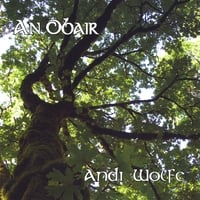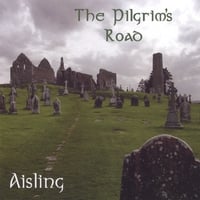
After our time in Doolin and such a busy visit to the Burren, we headed east toward Dublin again. We spent the night in a small village outside Athlone and then visited another monastery ruins. This one was called Clonmacnoise and I had wanted to visit it because of a picture Craig Caldwell (from my Irish band - Aisling) had taken from there. More on that later in this post.
This is a statue of "The Pilgrim" - on the path to the entrance of Clonmacnoise.

The visitor center was open, but without electricity for the day. Thus, we received a big discount on the visit, which was nice since we were nearing the end of our visit to Ireland and the unfavorable exchange rate was really taking a toll on my pocketbook.

The rain let up just a bit as we started to tour the grounds, but that respite was fairly short-lived. The dramatic sky made an excellent backdrop for these interesting ruins.

The cemetery was picturesque with the high crosses and other grave markers.

I couldn't decide on a favorite few images, so I'll just post a bunch here.



 This one needs a comment, though. This is taken from nearly the same spot as the one Craig Caldwell had taken, which we used as the cover for "The Pilgrim's Road" CD that Aisling recorded in 2007. The cover image is in the sidebar - check it out. BTW - The Pilgrim's Road would make a nice stocking stuffer for this Christmas (hint, hint). Clonmacnoise is undergoing restoration now, though, so the two images are slightly different.
This one needs a comment, though. This is taken from nearly the same spot as the one Craig Caldwell had taken, which we used as the cover for "The Pilgrim's Road" CD that Aisling recorded in 2007. The cover image is in the sidebar - check it out. BTW - The Pilgrim's Road would make a nice stocking stuffer for this Christmas (hint, hint). Clonmacnoise is undergoing restoration now, though, so the two images are slightly different.
There are a lot of buildings around the site, which you can learn more about from the Wikipedia entry on Clonmacnoise.

I had posted pictures of a monastery tower from Glendalough - here's another good example.

I think that chapel is still in current use.

Clonmacnoise is on the River Shannon.

This courtyard wasn't accessible to visitors, but I was able to get a picture through the gate.

I'm not sure what chapel this was.

There were so many interesting nooks and crannies to explore. It would have been nice if the visitor center were fully open so we could have done the orientation there.

Graves within one of the chapels.

The high crosses out on the grounds were replicas. The originals were inside the visitor center.

This must have been quite an amazing village during the medieval period.

The stonework that remains is beautiful and must have been absolutely stunning in its day.

These gems of viewpoints were all over the place. I wish the weather had been a bit nicer.

The high crosses were elaborately carved with Celtic symbols and bible story panels.

The original of this cross was in the visitor center and it's interesting to note that the staining is replicated here.

A detail of the motif.

The original cross - note the staining on the left arm. This part of the visitor center was closed, but one of the staff members was kind enough to guide us down to the exhibit space so that I could take some photos.

I don't have any info to share, though, since we didn't get to see the exhibit properly.



These are the ruins of Castle Clonmacnoise. The place was sacked in the 1500's.

It's hard to imagine what transpired here to bring down a castle with the walls as thick as these were.

The remnant of the mote with the River Shannon in the background.

I don't think it was particularly comfortable to live in, but it must have been impressive.

A few hundred meters down a narrow lane from Clonmacnoise is what's left of the Nun's chapel. The stonework on this chapel was very detailed and beautiful.

What an interesting door arch!

A detail of the stonework.

It was so surreal - especially with the rain pouring down.

Detail of the other arch.

Another angle.

It wasn't a very large chapel, but I can imagine a liturgy full of beautiful music and windows overlooking the pastoral scene of the surrounding area.

I'm glad we took the time to visit the Nun's Chapel.











2 comments:
that door arch is classic norman dog tooth. if it was England I'd date it to 1100-1120 ish.
I love the old celtic crosses.
That's probably about right, Pete. Clonmacnoise was established earlier than that time frame, but mostly in wood which would have been replaced by stone in the 1100's.
I'm with you on the high crosses. I really enjoyed seeing them and the old cemeteries.
Post a Comment